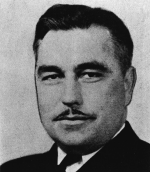
050114101 |
212k | Secretary of the Navy (SECNAV) Carlos Del Toro announced, today, that a DDG 51 Flight III Arleigh Burke-class guided-missile destroyer will be named after World War II hero Ernest E. Evans, the first Native American in the Navy to earn the Medal of Honor and one of only two World War II destroyer captains to attain it.
Secretary Del Toro made the announcement during Native American Heritage month. Additionally, Secretary Del Toro announced that the ship’s sponsor will be U.S. Secretary of the Interior Deb Haaland, the first Native American to serve as a cabinet secretary.
“Since our nation’s founding, Native Americans, such as Ernest Evans, have volunteered to serve in our armed services. From the Revolutionary War, the Civil War, World War I and II, to Korea, Vietnam, Desert Storm, and the conflicts in Iraq and Afghanistan, Native Americans have fought with honor and distinction to preserve our union and defend our ideals of freedom and democracy, even during periods where they were not recognized as citizens of our country,” said Secretary Del Toro.”
“Today, we honor Commander Ernest Evans for his courage and ultimate sacrifice,” said Secretary Deb Haaland. “While this nation has not always welcomed them, Native Americans have consistently and honorably served in disproportionately high rates across the Armed Forces to keep us safe at home and abroad. As we honor Commander Evans with this stunning vessel, we also honor the service of Indigenous servicemembers nationwide, past and present. Native American history is American history, and today’s designation ensures that our story continues to be told.”
Ernest Edwin Evans was born 13 August 1908, in Pawnee, Oklahoma. Of Cherokee/Creek ancestry, he graduated from Central High School in Muskogee, Oklahoma, and enlisted in the U.S. Navy on 29 May 1926. After a year's enlisted service, he was appointed to the U.S. Naval Academy, entered as a midshipman, and graduated with a Bachelor of Science degree in June 1931.
Evans spent his first decade of service in San Diego, Pensacola, and aboard seven ships (Colorado, Roper, Rathburne, Pensacola, ChaumontCahokia and Blackhawk). He was serving on his eighth, destroyer Alden (DD-211), in the East Indies when the Japanese attacked Pearl Harbor, thrusting the U.S. into World War II. Assuming command 17 March 1942, Evans served as Alden's CO until being assigned to fit out a new destroyer in July 1943.
On 27 October 1943, Commander Evans assumed command of the USS Johnston (DD-557), serving as its only commanding officer. During the commissioning ceremony, Cmdr. Evans reportedly told his crew and the audience assembled, “This is going to be a fighting ship. I intend to go in harm’s way, and anyone who doesn’t want to go along had better get off right now.”
Oct. 25, 1944, off the coast of the Philippines, Cmdr. Evans and the crew of the USS Johnston found themselves in harm’s way during the Battle of Leyte Gulf. On that day, Cmdr. Evans and his fellow destroyer captains launched an offensive attack against overwhelming odds against a much larger Japanese naval force, with the USS Johnston in the lead. Not waiting for orders, Evans commanded the crew to begin a torpedo run, drawing fire away from the carriers, directly taking hits from three powerful 14-inch guns. Despite severe damage to his ship and his own wounds from Japanese fire, he repeatedly put the USS Johnston between the enemy and more vulnerable U.S. ships, saving the lives of thousands of his fellow Sailors.
Ultimately, the USS Johnston was lost during the Battle of Leyte Gulf, with Cmdr. Evans going down with his ship. For his leadership and selfless service in the face of a superior enemy force, he was posthumously awarded the Medal of Honor.
“And I am honored to announce that, in recognition of his heroic actions, our Navy will once again welcome a USS Ernest E. Evans into our fleet once again, as his name will adorn our future Arleigh Burke Flight III class destroyer DDG-141,” said Secretary Del Toro.
In addition to the Medal of Honor, the Bronze Star, Purple Heart, and Presidential Unit Citation Ribbon, Cmdr. Evans had the China Service Medal, American Defense Service Medal, Fleet Clasp, and was entitled to the Asiatic-Pacific Campaign Medal with six engagement stars, the World War II Victory Medal, and the Philippine Defense and Liberation Ribbons with the one star.
A destroyer escort vessel, USS Evans (DE 1023), was named in honor of Commander Evans. Mrs. Hugh Hendrickson of Tulsa, Oklahoma, sister to Cmdr. Evans, sponsored the vessel at the launching at the Puget Sound Bridge and Dredging Company, Seattle, Washington, on 14 September 1955.
Naval History & Heritage Command photo NH 92320
| Dave Wright |

